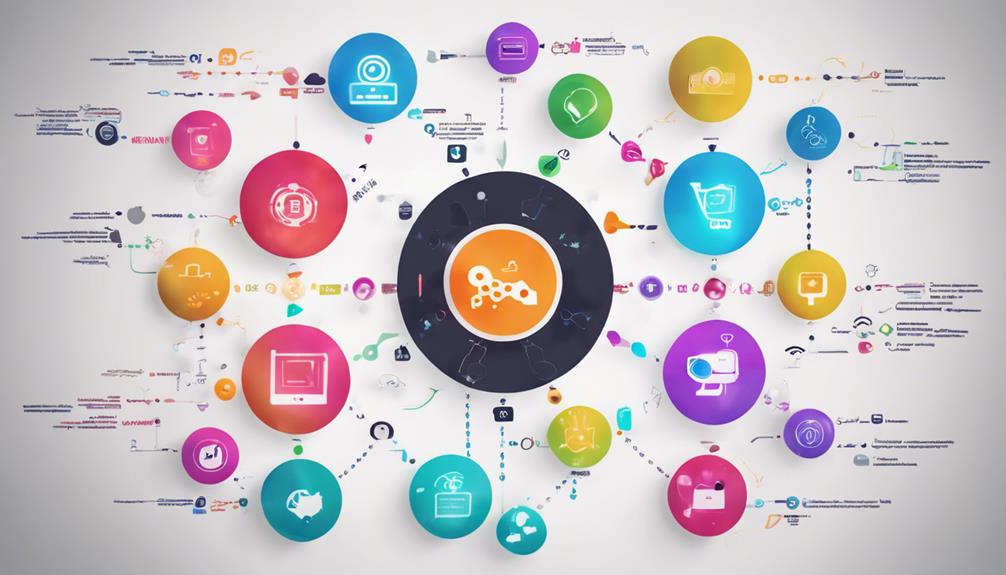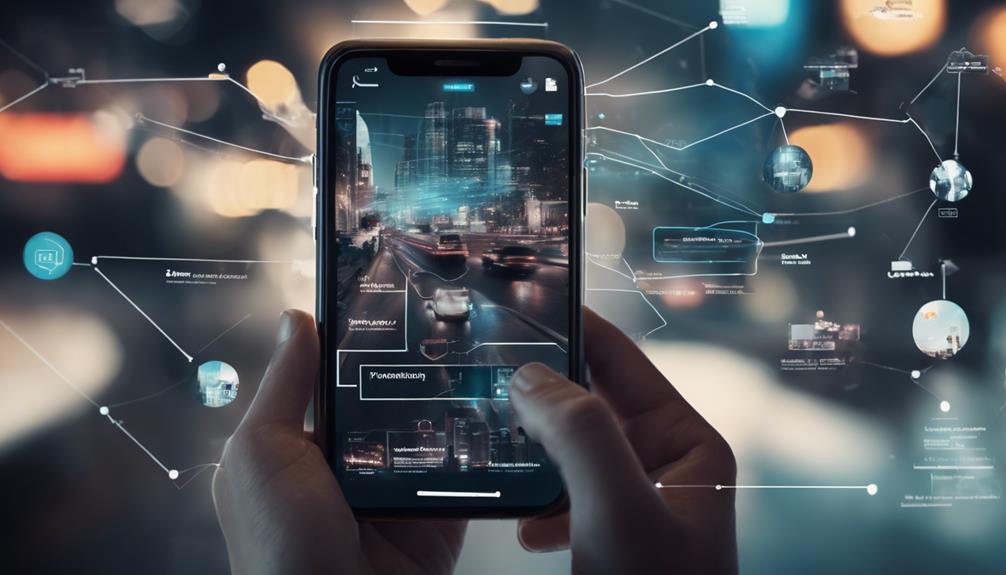I've seen firsthand how technology can transform customer journey mapping. It starts with visualizing touchpoints and understanding customer emotions. By using mapping software like UXPressia and cloud-based tools like Custellence, we can identify pain points and improve satisfaction by 20%. AI further enhances this process by predicting behaviors and personalizing experiences. Real-time collaboration and intuitive interfaces streamline mapping, boosting revenue by 15%. With machine learning and AI algorithms, we can automate data collection and optimization. If you're curious about how these digital tools lead to personalized interactions and elevated customer experiences, there's more to discover.
Key Takeaways
- Customer journey mapping with technology visualizes customer interactions using tools like UXPressia and Lucidchart.
- AI enhances personalization and optimizes customer touchpoints with machine learning and natural language processing.
- Digital tools streamline mapping processes and enable real-time collaboration with customizable templates.
- Cloud-based solutions like Custellence allow mapping and analysis from anywhere, improving flexibility.
- AI-powered algorithms automate data collection and trend identification, enhancing customer satisfaction.
Understanding Customer Journey Mapping
Understanding customer journey mapping is vital because it lets us visualize every touchpoint and emotion our customers experience with our brand. By creating a visual representation, we can better understand our customers' needs and identify their pain points. This is essential for improving the customer experience.
Data and feedback on social media reveal the stages our customers go through, from initial awareness to purchase decisions. Using this information, we pinpoint areas needing enhancement, ensuring a smoother journey.
Studies show that effective customer journey mapping can boost satisfaction by 20% and increase revenue by 15%. Ultimately, this approach helps us foster loyalty and drive innovation, creating a more seamless and satisfying experience for our customers.
Role of Technology in Mapping
Technology revolutionizes customer journey mapping by providing sophisticated tools that visualize every interaction and touchpoint in real time. These tools make it easier for us to create detailed customer journey maps, enhancing our understanding of customer behavior and improving our strategies.
- Customer journey mapping software: UXPressia and Lucidchart offer customizable templates and real-time collaboration features.
- Intuitive interface design: Tools like Microsoft Visio and Gliffy allow for flexible map structures.
- Agile project management: Visual Paradigm enhances the mapping process and information acquisition.
- Cloud-based mapping tools: Custellence and UpWave provide user-friendly interfaces and drag-and-drop functionality.
- Visualizing customer interactions: These technologies make understanding and analyzing touchpoints seamless and efficient.
Embracing these tools drives innovation and precision in our customer journey mapping efforts.
Benefits of Digital Tools

Harnessing the power of digital tools not only streamlines our customer journey mapping but also greatly boosts customer satisfaction and revenue.
A customer journey map gives us a visual representation of customer touchpoints, allowing us to create a customer journey that's both insightful and efficient. By leveraging real-time collaboration and customizable templates, we can gain a deeper understanding of customer data and feedback.
Tools like UXPressia and Lucidchart offer intuitive interfaces and flexible map structures, enhancing the mapping process. Cloud-based solutions such as Custellence enable us to analyze and optimize journeys from anywhere, improving our customer interactions.
Ultimately, these digital tools lead to a 20% increase in satisfaction and a 15% revenue boost by refining the customer experience.
AI in Customer Journey Mapping
Integrating AI into customer journey mapping transforms how we perceive and anticipate our customers' needs, creating more personalized and efficient experiences. AI uses machine learning to analyze vast amounts of data, unearthing valuable insights that improve the customer journey.
Automation helps streamline data collection and visualization, making the customer journey map more accurate and insightful.
- Enhanced Personalization: AI predicts customer preferences, tailoring experiences to individual needs.
- Efficient Data Collection: AI automates data gathering, reducing manual efforts.
- Insightful Trends: Machine learning identifies trends, aiding strategic decision-making.
- Improved Visualization: Automated tools create clear, visual maps for better understanding.
- Optimized Processes: AI-driven insights lead to optimized processes and improved customer satisfaction.
Key AI Technologies Used

In the domain of customer journey mapping, AI technologies like machine learning and natural language processing revolutionize how we comprehend and enhance customer experiences. These technologies analyze vast data to uncover patterns in customer behavior, which is vital for effective personalization and optimizing touchpoints. AI-powered algorithms automate journey mapping, saving time and boosting accuracy. By leveraging these innovations, businesses can predict customer behavior and tailor experiences to stay ahead of expectations.
Here's a breakdown of key AI technologies:
| Technology | Function | Benefit |
|---|---|---|
| Machine Learning | Data Analysis | Predict Customer Behavior |
| Natural Language Processing | Understand Customer Sentiment | Personalization |
| AI-Powered Algorithms | Automate Mapping | Improve Accuracy |
| Data Analysis Tools | Identify Patterns | Enhance Insight |
| Optimization Tools | Optimize Touchpoints | Increase Satisfaction |
Understanding and leveraging these technologies are essential to mastering the customer journey.
Data Collection and Analysis
When I gather data for customer journey mapping, I focus on collecting relevant information from surveys, interviews, and behavioral data like purchase history. Analyzing these patterns helps me understand each touchpoint from the customer's perspective.
Gathering Relevant Data
Understanding customer behavior starts with gathering relevant data through methods like surveys, interviews, and analyzing unsolicited data such as purchase history and email clicks.
Each piece of data from customer surveys and past behavior helps create an accurate mapping of the customer journey. By focusing on customer interactions at various touchpoints, we can enhance the overall customer experience. Technology plays a pivotal role in collecting and analyzing this data seamlessly.
- Customer journey: Track the entire customer lifecycle.
- Data from customer surveys: Gather direct feedback.
- Unsolicited data: Analyze purchase history and email clicks.
- Customer interactions: Monitor touchpoints to understand experiences.
- Past behavior: Identify patterns to predict future actions.
These insights are the foundation for a deeper, more empathetic understanding of our customers.
Analyzing Behavioral Patterns
Analyzing behavioral patterns involves diving into the wealth of data we've gathered to uncover meaningful insights about our customers' actions and preferences. By meticulously collecting data through surveys, interviews, and unsolicited data like purchase history and email clicks, we can start to visualize experiences and map out the customer journey.
Behavioral analysis allows us to decode customer interactions and user actions, even when these journeys are non-linear, marked by back-and-forth and multi-channel interactions. Each piece of data helps us not only understand past behavior but also predict future actions, ensuring our customer journey maps are accurate and insightful.
This data-driven approach enables us to empathize with customers and tailor solutions that resonate with their unique needs and behaviors.
Leveraging Analytical Tools
We've uncovered valuable insights from behavioral patterns, and now it's time to leverage analytical tools that will help us gather and analyze this data for a more detailed customer journey map.
By using advanced analytical tools, we can track customer touchpoints, interactions, and emotions throughout their entire journey. This approach allows us to capture feedback, survey responses, and behavioral patterns more thoroughly.
- Data Collection: Gather thorough customer feedback.
- Behavioral Analysis: Identify key trends and pain points.
- Touchpoint Tracking: Monitor interactions at every stage.
- Emotional Insight: Understand customer emotions during their journey.
- Feedback Integration: Incorporate real-time survey responses.
Leveraging these analytical tools enables us to create insightful, data-driven customer journey maps, ultimately improving the overall customer experience.
Personalizing Customer Interactions

Personalizing customer interactions isn't just a buzzword; it's an essential strategy, with 80% of buyers valuing these tailored experiences as much as the products or services themselves.
To enhance the Customer Journey, tech marketers harness data to create Personalized Interactions that truly resonate. By understanding Customer Needs and addressing pain points, we can craft Customized Offers that hit the mark. This data-driven approach boosts Enhanced Satisfaction and retention, proving invaluable for Sales and Marketing teams.
When we map out the journey, we see where we can alleviate Customer Pain Points and elevate the overall experience. In today's competitive landscape, personalizing every touchpoint isn't optional; it's a necessity for meeting customer expectations and driving growth.
Future Trends in Journey Mapping
As I look to the future of customer journey mapping, I see AI-powered personalization techniques transforming how we interpret and engage with customers on an individual level.
Predictive analytics will enable us to anticipate customer behaviors and enhance touchpoints across an integrated omnichannel experience.
AI-Powered Personalization Techniques
Frequently, AI-powered personalization techniques revolutionize customer journey mapping by leveraging data and algorithms to create deeply tailored experiences. Through advanced data analysis, these methods analyze customer behavior and preferences, crafting personalized touchpoints that enhance the overall customer experience.
By predicting needs and recommending products in real-time, AI guarantees higher customer satisfaction and retention rates.
Consider these impactful aspects:
- Data analysis: Uncover deep insights into customer behavior.
- Personalized touchpoints: Tailor interactions to individual preferences.
- Real-time data: Adapt experiences dynamically as customers engage.
- Customer satisfaction: Increase happiness through relevant interactions.
- Higher retention rates: Foster loyalty with consistent, personalized experiences.
Embracing AI-powered personalization in customer journey mapping means we can anticipate needs and deliver exceptional, data-driven experiences.
Omnichannel Experience Integration
Integrating an omnichannel experience into customer journey mapping allows us to create a seamless and cohesive interaction across various touchpoints like social media, websites, and mobile apps.
By leveraging AI-driven personalization and real-time data integration, we can track customer behavior across multiple channels, guaranteeing a consistent brand experience. This technology integration not only adapts to customer preferences in real-time but also provides personalized experiences that resonate deeply with users.
Predictive analytics further enhance this process by offering insights that optimize the customer journey. Ultimately, a seamless customer experience built on these foundations leads to higher satisfaction and loyalty.
As we innovate, focusing on these elements ensures we meet and exceed customer expectations at every interaction.
Predictive Analytics Applications
Predictive analytics revolutionizes customer journey mapping by using data to forecast future behaviors and trends, helping us tailor experiences that truly resonate with each individual.
By delving deep into historical data, we can predict customer behavior, allowing us to craft personalized experiences that boost customer satisfaction.
Machine learning algorithms uncover patterns, enabling us to anticipate needs and refine our marketing strategies. This proactive approach leads to more meaningful interactions and long-term loyalty.
—
- Analyze historical data to predict future customer behavior
- Use machine learning algorithms to identify patterns
- Create personalized experiences that enhance customer satisfaction
- Anticipate customer needs for proactive engagement
- Develop data-driven marketing strategies to stay ahead of trends
Frequently Asked Questions
What Is Digital Customer Journey Mapping?
Digital customer journey mapping lets me analyze touchpoints, track behavior, and design experiences. By leveraging user personas, journey analytics, and digital touchpoints, I optimize interactions and understand customer personas to enhance engagement and satisfaction.
What Are the 4 Stages of Customer Journey Mapping?
In the four journey stages, I use buyer personas and data analytics to map touch points and pain points. From awareness to retention, customer emotions and feedback shape the user experience, guided by insightful market research.
What Are the 5 Key Components of Customer Journey Map?
For the Current Question, I'd say the 5 key components are user personas, touchpoint analysis, customer emotions, interaction channels, and customer goals. Journey visualization, behavioral insights, and satisfaction metrics help identify experience gaps and pain points.
What Are the 7 Steps to Map the Customer Journey?
To map the customer journey, I set objectives, create personas, define touch points, analyze data, map stages, gather feedback, and improve. By addressing pain points, customer emotions, and experience gaps across interaction channels, I meet user goals.
Conclusion
In the intricate dance of customer journey mapping, technology is the maestro orchestrating each step. With AI as our guiding star, we navigate through data seas to craft personalized experiences.
It's like planting seeds in a digital garden, where each touchpoint blooms into deeper connections.
As we look ahead, the horizon promises even richer landscapes, where empathy and data intertwine, creating paths that lead to loyal, satisfied customers.






